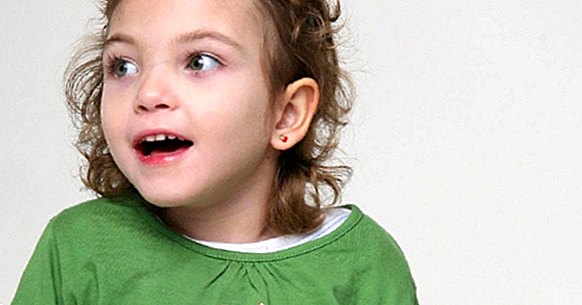Rett syndrome: causes, symptoms and treatment
Rett syndrome is an autism spectrum disorder It starts in early childhood and occurs mainly in girls. It is characterized by the presence of microcephaly and the loss of motor skills acquired during the first months of life.
These and other symptoms are caused by genetic mutations related to the X chromosome. Although for the moment Rett's disorder has no cure, there are treatments and interventions that can alleviate the different problems involved and improve the quality of life of girls with this syndrome.
- You may be interested: "Fragile X syndrome: causes, symptoms and treatment"
What is Rett syndrome?
In 1966 the Austrian neurologist Andreas Rett described a childhood onset disorder consisting of "cerebral atrophy with hyperammonemia", that is, characterized by excessive levels of ammonia in the blood. Later the relationship of this syndrome with hyperammonemia would be refuted, but the clinical picture described by Rett would be baptized with his surname.
Rett syndrome is an alteration of the physical, motor and psychological development which occurs between the first and fourth years of life, after a period of normal growth. The most characteristic symptoms are the deceleration of the cranial development and the loss of manual skills, as well as the appearance of stereotyped movements of the hands.
This disorder occurs almost exclusively in girls; In fact, both the ICD-10 and the DSM-IV claim that it only affects women, but recently some cases of Rett syndrome have been detected in children.
Because males only have one X chromosome, in which the genetic defects typical of Rett syndrome are located, the symptoms are corrected to a lesser extent than in women, giving rise to more serious variants that carry an increased risk of death early.
Related article: "The 4 types of Autism and its characteristics"
Relationship with other autism spectrum disorders
Currently the DSM-5 classifies it within the category "Autism Spectrum Disorders" (ASD) , a label that it shares with other more or less similar syndromes that differed in the DSM-IV: the autistic disorder, the Asperger syndrome, the infantile disintegrative disorder and the generalized disorder of the unspecified development.
In this sense, Rett syndrome is considered a neurological disease, not a mental disorder . For its part, the ICD-10 classification categorizes Rett's disorder as an alteration of psychological development. In particular, according to this medical manual it is a generalized disorder of development, a conception similar to that of the DSM-IV.
Rett syndrome differs from childhood disintegrative disorder in that it usually begins earlier: while the former usually occurs before 2 years of age, childhood disintegrative disorder occurs slightly later and its symptoms are less specific. In addition, Rett syndrome is the only autism spectrum disorder that it is more prevalent in women than in men .
Symptoms and signs of this disorder
The prenatal and perinatal development of girls with Rett syndrome is normal during the first 5 or 6 months of life, approximately. However, in some cases the small can continue to grow normally until 2 or 3 years.
After this period the growth of the skull slows down and there is a decline in motor skills , especially of the fine movements of the hands; consequently repetitive or stereotyped manual movements are developed, which include writhing and wetting with saliva.
In addition to microcephaly and manual alterations, people who have Rett's disorder may present a series of associated signs and symptoms with a variable frequency:
- Severe intellectual disability .
- Gastrointestinal disorders such as constipation.
- Alterations in cerebral bioelectrical activity and appearance of epileptic seizures.
- Absence of language or serious linguistic deficits.
- Deficits in social interaction, although interest in others is maintained.
- Difficulty walking , lack of coordination of the march and movements of the trunk.
- Inadequate chewing
- Respiratory disorders such as hyperventilation, apnea or air retention.
- Scoliosis (abnormal curvature of the spine).
- Drooling
- Difficulties in sphincter control.
- Brief spasms (chorea) and involuntary contortions (athetosis).
- Muscular hypotonia
- Characteristic social smile during early childhood.
- Avoidance of eye contact.
- Shouts of screams and uncontrollable cries .
- Bruxism (clenching teeth involuntarily).
- Cardiovascular disorders such as arrhythmia.
Causes
The cause of this disorder is the mutation in the MECP2 gene , which is located on the X chromosome and plays a key role in the functioning of neurons. Specifically, MECP2 silences the expression of other genes, preventing them from synthesizing proteins when it is not necessary. It also regulates methylation of genes, a process that modifies gene expression without altering DNA.
Although alterations in this gene have been clearly identified, the exact mechanism by which the symptoms typical of Rett syndrome develop are not known.
Mutations in the MECP2 gene in general They do not depend on inheritance but are usually random , although a family history of Rett's disorder has been found in a small number of cases.
Prognosis and treatment
Rett syndrome is maintained throughout life. Deficits are not usually corrected; rather, they tend to increase over time. If it occurs, the recovery is discrete and usually limited to the improvement of social interaction capabilities at the end of childhood or at the beginning of adolescence.
The treatment of Rett syndrome is basically symptomatic, that is, focused on the reduction of multiple problems. Therefore, interventions vary depending on the specific symptom that is intended to alleviate.
At the medical level, antipsychotic drugs and beta-blockers are usually prescribed, as well as selective inhibitors of serotonin reuptake. Nutrition control can help prevent weight loss which is typically derived from the difficulties of chewing and swallowing food.
Physical, linguistic, behavioral and occupational therapy may also be useful in reducing the physical, psychological and social symptoms of Rett syndrome. In all cases, intense and continuous support from different types of health services is required to empower girls with Rett to develop in the most satisfactory way possible.



















